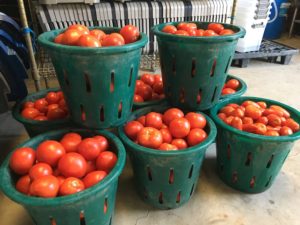8 Ways to Use Up Lots of Tomatoes

When the tomatoes come on, you better have some strategies to move them…
And just like that, the tomatoes have taken over. Doesn’t it seem that two weeks ago, we were waiting with bated breath for the tomatoes to even start?
Every year I feel guilty that I didn’t take advantage of the tomatoes while they were here. Instead, I let myself get overwhelmed and just give up.
Then in the winter, when I’m eating cardboard tomatoes from the store, I am wishing I’d taken the time to store up that great summer taste.
Preserving tomatoes does take a little bit of time, but there are some short-cuts you can use, especially if you have lots of freezer space.
Here are 8 ways to store away those tomatoes.
1.Can them whole.
I like to can globe tomatoes, and use them in my pasta sauces and soups later in the year, but other CSA masters will use Romas or even heirlooms (although those will have a lot of water in the jar). Canning sometimes feels a little scary to newbies in the CSA. I get it. But I’ve created a terrific email training that will take away the fear factor and get you one step closer to trying your first batch.
To grab my Canning Equipment Checklist to get started, subscribe below.
You’ll be subscribed to an email drip campaign for a couple weeks, that will teach you what you need to know.
Get the Canning Equipment Checklist
Want to learn how to can, but feeling a bit intimidated? Where do you even start? Download our Canning Equipment Checklist. It includes a visual guide for everything a beginning canner will need to start preserving, including 6 of our easiest starter recipes. You'll also be subscribed to our emails which will slowly bring you confidence in taking the first step to canning mastery!
2. Slow-roast them.
This is a VERY popular exit strategy for our CSA masters. And again, the tomato variety doesn’t matter, although you’ll get the best results with Romas or cherry tomatoes.
Quick results: You can either roast them “hot and fast” at 400 F for 20-30 minutes, or “low and slow” at 300 F for 90 minutes. To do so, take the Romas or cherries, cut them length-wise in half and place them cut-side up in the non-reactive baking pan. (You can coat them in olive oil and salt first if you wish). Use the finished product for concentrated tomato flavor in marinara, pizza sauce, hummus, tomato pesto, or vinaigrettes. (You’ll have to run them through a food mill to remove the seeds and skins prior to use).
Overnight: If you want to “fix it and forget it” you can roast them overnight while you sleep. Set your oven at its lowest setting around 150-175 F before you go to bed and roast for about 8 hours until you get the desired level of dryness.
Store the dried tomatoes in a Ziploc bag and freeze/refrigerate, or place them in a quart-size Mason jar covered with this olive oil seasoning and refrigerate. (Use this recipe: 3 cups olive oil, 2 tablespoons Italian Seasoning, 1/4 t. garlic, 2 T. of balsamic vinegar, 2 t. lemon juice, 1 t. salt, freshly ground pepper to taste).
Watch our YouTube video here to see how to slow-roast.
3. Dehydrate them.
Once again, I would recommend this step for Romas, globes, or cherry tomatoes — not heirlooms! (Way too much water). Wash and core the tomatoes. Slice the tomatoes about ¼ inch thick and place on the dehydrator racks. No peeling. Then set the temperature at 155 degrees (or what ever your dehydrator instructions say) for about 5-8 hours (depends on the size of your tomatoes). It takes 4 lbs. of tomatoes to yield one quart of dehydrated tomatoes.
4. Freeze them
So many people don’t realize you can freeze tomatoes super easily. Ideally, you want to remove the skins before you freeze, but you don’t have to! Frozen tomatoes are great for soups and sauces later in the year.
Non-Peeled: Flash freeze! Just bag your tomatoes in a freezer Ziplock and freeze! When you thaw them for later use in a soup or pasta dish, the skins will come right off. If you don’t take the time to thaw them first so you can de-skin them, they skins will come off in your dish (and you can either eat them or skim them out — a little annoying but hey, it works).
Peeled: If you want to skin the tomatoes first, place an “x” in the end of the tomato with a paring knife and drop the tomato into a pot of boiling water for 30 seconds. Remove and the skins will pull right off. Then freeze them whole in Ziplock, or cut them into chunks before you freeze.
Watch our YouTube Tutorial video showing 3 ways to peel a tomato.
Another fast way to peel tomatoes is to broil tomato halves in the oven for 3-4 minutes, skin-side up. The skins will shrivel up and remove some of the moisture.
You can also freeze the peeled tomato chunks in little mini muffin tin trays, then pop them out into a Ziplock bag. This is a great option if you want to control your portion sizes, and makes it easy to just pop in the right amount of tomatoes in recipes later on.
Watch our YouTube Video tutorial here on how to freeze tomatoes.
5. Make Marinara Sauce
Once you’ve roasted or frozen some of those tomatoes, you can pull them out of your Ziplock baggie, run them through a food mill (to remove the seeds and skins), and use them in a marinara sauce. (This will cut down the cooking time immensely). Or just whip out the frozen tomatoes as your base. You can then make large batches of marinara sauce and freeze it or can it! Here’s a good basic recipe.
Remember, if you want to can marinara, you should use a recipe that’s been kitchen tested — especially if it has other veggies in it! Those veggies alter the pH of the sauce, and may cause spoilage later on. Pressure canning is also highly recommended for marinaras that use other veggies.
6. Make Salsa

Globe tomatoes make really great canned tomatoes.
This is a great easy way to get rid of your tomatoes. There are countless salsa recipes online to experiment with, but the basics involve tomatoes, onions, garlic, cilantro, peppers or jalapeno, and lemon juice. Remember, if you want to can a salsa, be sure you use a kitchen-tested-approved recipe for safety.
To see my article on 9 Ways to Use Salsa, click here.
7. Tomato Purée
Puree can be used for making pasta or pizza sauce. If you don’t have time to make the sauce right away, you can just make the puree and then freeze it in Ziplock baggies (or ice cube trays) in your desired portion sizes. The best tomatoes for this purpose are Romas, as they have the least amount of water.
Coarsely chop tomatoes and simmer until the fruits begin to break down. Purée the tomatoes in a blender, or pass through a food mill if you’d like to remove seeds and skins. Return the purée to the stove and simmer it to your desired thickness. It can take many hours for the puree to cook down, so be ready! A longer-cooked, thicker puree with garlic, onions, and herbs added makes a great pasta or pizza sauce.
8. Make Tomato Juice
Follow the instructions for tomato puree, but use globe tomatoes or heirlooms for the best results and flavor. After passing the cooked tomatoes through the food mill, return the puree to the stove and simmer for a short time. Then refrigerate for immediate use or freeze/can for later use. Use in Bloody Marys or as a base for soups and chili. Here’s a good basic recipe for juice.
Basic Tomato Juice
Adapted from The Urban Farmer
Wash 5-20 pounds of ripe red tomatoes and then core and quarter them.
Use a large stainless steel pot so it doesn’t react to the acidity of the tomatoes. Place the tomatoes in the pot. For flavor add small halved red onion, one celery rib with leaves, lemon juice, and carrots for flavor.
Cover and cook over medium heat, stirring often. Cook for about 30 minutes until tomatoes are soft.
Discard the optional ingredients. Pass the tomatoes through a food mill. Discard the solids. Use the smaller holed-insert for your food mill.
Measure the juice. Rinse the pot. Return the juice to the pot. Add 1 teaspoon of sugar and up to 1 teaspoon of salt for each 4 cups of tomato juice. Add pepper to taste.
Stir as you bring the pot to a boil, and then reduce the heat to boil gently for 5 minutes.
Cool, then chill. If desired, you can pour the juice through a sieve to filter out any thick areas or seeds that may have passed through the food mill. May be refrigerated for up to three days.
